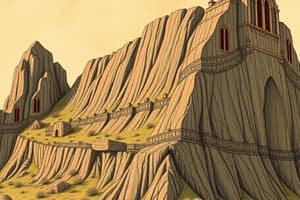Podcast
Questions and Answers
What does the lithosphere deal with?
What does the lithosphere deal with?
- Earthquakes, volcanoes, and plate tectonics
- Atmosphere, hydrosphere, and biosphere
- Soil, rocks, and minerals (correct)
- Earth's crust, mantle, and core
What are the three main types of rocks classified according to their origin?
What are the three main types of rocks classified according to their origin?
- Igneous, sedimentary, and metamorphic (correct)
- Intrusive, extrusive, and porphyric
- Crystalline, amorphous, and clastic
- Plutonic, volcanic, and porphyric
What is the defining characteristic of igneous rocks?
What is the defining characteristic of igneous rocks?
- They are formed by the transformation of existing rocks due to changes in temperature, pressure, or chemical composition
- They are formed from the cooling and solidification of magma or partially melted rock (correct)
- They are formed by the layering and subsequent compression of organic material
- They are formed from the weathering and erosion of pre-existing rocks
What is the defining characteristic of intrusive igneous rocks?
What is the defining characteristic of intrusive igneous rocks?
What is the defining characteristic of extrusive igneous rocks?
What is the defining characteristic of extrusive igneous rocks?
What is the defining characteristic of sedimentary rocks?
What is the defining characteristic of sedimentary rocks?
What is the primary characteristic that distinguishes metamorphic rocks from igneous and sedimentary rocks?
What is the primary characteristic that distinguishes metamorphic rocks from igneous and sedimentary rocks?
What property of minerals is measured on the Mohs Hardness scale?
What property of minerals is measured on the Mohs Hardness scale?
What does the 'streak' of a mineral refer to?
What does the 'streak' of a mineral refer to?
Which of the following is NOT a method used to classify minerals?
Which of the following is NOT a method used to classify minerals?
What is the key difference between minerals and rocks?
What is the key difference between minerals and rocks?
What is the defining characteristic of the mineral $\text{garnet}$?
What is the defining characteristic of the mineral $\text{garnet}$?
Flashcards are hidden until you start studying
Study Notes
Lithosphere
- The lithosphere comprises the Earth's outermost shell, including the crust and the upper mantle, involved in tectonic activities and geological processes.
Types of Rocks
- Three primary rock types based on origin:
- Igneous rocks
- Sedimentary rocks
- Metamorphic rocks
Igneous Rocks
- Characterized by the solidification of molten rock, either magma underground or lava on the surface.
Intrusive Igneous Rocks
- Formed from magma that cools slowly beneath the Earth's surface, resulting in larger, visible crystals.
Extrusive Igneous Rocks
- Created from lava that cools quickly on the Earth's surface, leading to fine-grained textures and small or no visible crystals.
Sedimentary Rocks
- Formed through the accumulation and compaction of sediments, often containing fossils and layers indicating environmental history.
Metamorphic Rocks
- Distinguished from igneous and sedimentary rocks by undergoing transformation through heat and pressure, resulting in altered mineralogy and texture.
Mohs Hardness Scale
- Measures the hardness of minerals on a scale of 1 to 10, reflecting their resistance to scratching, with talc at 1 (softest) and diamond at 10 (hardest).
Streak of a Mineral
- Refers to the color of the powder produced when a mineral is dragged across a porcelain plate, providing insight into its identity.
Mineral Classification Methods
- Common methods include crystal structure, chemical composition, and physical properties such as luster, hardness, and color, while methods like "color alone" may NOT be reliable for classification.
Minerals vs. Rocks
- Minerals are naturally occurring, inorganic solids with a definite chemical composition and crystal structure, while rocks are composed of one or more minerals or mineraloids.
Garnet
- Defined by its characteristic isometric crystal structure, often occurring in various colors and commonly used as a gemstone and abrasive.
Studying That Suits You
Use AI to generate personalized quizzes and flashcards to suit your learning preferences.




